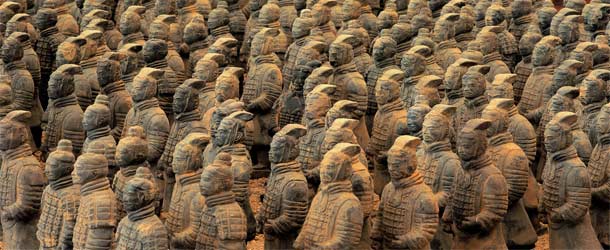If you book a river cruise along China’s Yangtze, not only will you have the honour of sailing the third longest river in the world, you’ll also have the chance to see one of its most famous and fascinating archaeological discoveries – the Terracotta Army at Xian. Though Xian is not situated on the Yangtze itself, it’s relatively short flight away from Chongqing, which is a key port for Yangtze river cruises and whichever direction you sail on the Yangtze, you’ll stop off at Xian on your way to or from Beijing.
The Terracotta Army is exactly what it sounds like – a massive collection of clay sculptures which represent the armies of Qin Shi Huang – China’s first emperor. Functioning in much the same way as decorative mausoleum, the statues were buried along with the emperor in 209BC, with the intention of protecting him in the afterlife. The statues continued to stand guard over their emperor for hundreds of years until they were discovered by local farmers who were digging a well in the area. The emperor’s act ual tomb mound was located a mile away at Mount Li, so as far as the farmers were concerned, they were digging a safe distance away from any area of historical importance. Through the centuries, there had been reports of terracotta fragments of figures being unearthed in the area where the farmers worked but this latest discovery prompted an in-depth investigation by archaeologists, which uncovered one of history’s most awesome and expansive finds.
ual tomb mound was located a mile away at Mount Li, so as far as the farmers were concerned, they were digging a safe distance away from any area of historical importance. Through the centuries, there had been reports of terracotta fragments of figures being unearthed in the area where the farmers worked but this latest discovery prompted an in-depth investigation by archaeologists, which uncovered one of history’s most awesome and expansive finds.
The archaeologists could not possibly have known the scale of their find and as the dig continued, they unearthed four main pits containing warrior after warrior – some soldiers, some generals – even the cavalry horses were there. The investigation inevitably expanded to the area around the emperor’s tomb mound, where a huge man-made necropolis was unearthed. This was a faithful reproduction of the emperor’s palace, containing offices, halls and stables.
So what do we know?
Archaeologists noted that the statues varied in height according to their roles; generals the tallest, soldiers the smallest, and so on. Three of the pits contain the army exclusively and though the majority of these are still buried, estimates suggest a total of 8,000 soldiers, 670 horses and 130 chariots. Other non-military figures such as officials and musicians were also unearthed, suggesting the emperor’s entire court had been realised in clay.
How was it done?
The historian Sima Qian (145-90BC) believed that work began on the mausoleum as soon as the emperor ascended the throne at the age of 13 and the construction involved 700,000 workers. He held that the emperor was buried with “palaces, towers, officials and wonderful objects” but made no mention of the warriors. Studies show that the statues were manufactured in workshops and that the arms, legs, heads and torsos were all created separately, and then assembled. Eight different face moulds were used to create a contrasting range of facial features and evidence of pigmentation was found, which indicates that each figure was originally painted, too.
What will I see?
Today, though many of the warriors and other statues remain unearthed, there’s a large section of the site which is open to public. There are several viewing areas, though photography and filming is only permitted in some of them and unless you’re the Queen, you won’t be allowed to walk into the pits and view the warriors up close. However, the site of row upon row of warriors lined up and now safely enclosed in an area which resembles a huge aircraft hangar is truly an awe-inspiring one, and will give you just as small idea of the sheer scale and enormity of the feat undertaken to honour China’s first emperor.
And what about the emperor?
To this day, the tomb of Qin Shi Huang remains untouched. Scientists have determined that it lies in a hermetically sealed area the size of a football pitch, located directly beneath the tomb mound. No-one knows what else the tomb may contain, though concerns about rare artefacts and treasures being damaged by dry air are a possible reason why it’s never been opened.
By Simon Brotherton
Google



